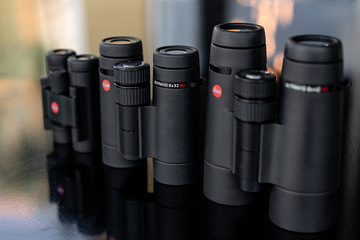
By Kirsten Vignes, LeicaStore Miami
I started with Leica six
years ago as a camera specialist. With a background and passion for
photography, I was quickly swept into the world of Summicrons and Elmarits, but
paid little attention to Leica’s purest optic: the binocular. After all, those
were only for bird nerds and boaters, right?
Over the years, however, I
came to realize that I couldn’t have been more wrong. Now I always keep a pair
of binoculars on hand. They’ve become an essential addition to my camera bag
(see “What’s In My Bag” here). On a recent rock climbing trip to Utah, I used
my Leica Noctivids to spot climbers high on Zion’s limestone cliffs. During a
family trip to India, I used them to hone in on the architectural details of
both ancient ruins and modern structures. At home in Miami I use them almost
daily. Whether at the beach watching ships steaming into port, or hitting a
local park and taking in South Florida’s plentiful wildlife, my binoculars are
always within arm’s reach.
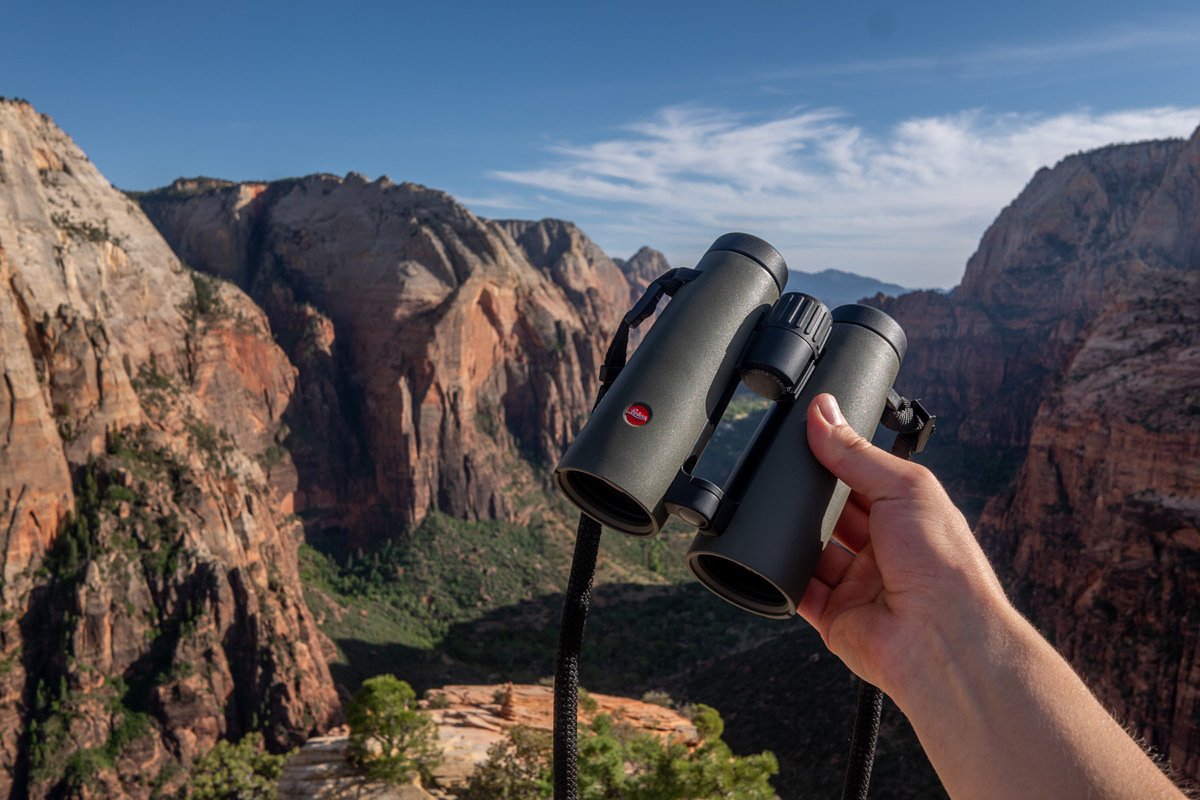
On a recent rock climbing
trip to Utah, I used my Leica Noctivids to spot climbers high on Zion’s
limestone cliffs.
(Pictured: Leica 8×42 Noctivid, Green)
(Pictured: Leica 8×42 Noctivid, Green)
Why Leica?
Whether a first-time
binocular buyer, or a veteran birder looking to upgrade, researching and buying
a new pair can be a confusing, frustrating experience. A big step in this
decision-making process is choosing the right brand. For those of you who are
familiar with Leica’s photographic lenses, you know the name Leica is
synonymous with quality. Leica sport optics are no exception. Each binocular is
assembled and inspected by hand, subjected to the highest measures of quality
control.
Leica sport optics are
built to withstand the harshest of conditions. All of Leica’s full-sized
rubber-armored binoculars, from the entry level Trinovid HD’s to the
high-performance Noctivids, feature a nigh-indestructible magnesium or
magnesium alloy body and are shockproof. They’re sealed and filled with
nitrogen making them waterproof up to 4/5m and impervious to fogging. Each
outer element is finished with a water-repellent AquaDura lens coating, causing
water to bead up and fall off. In short,
they’re built to be used.
And Leica stands behind
this. All Leica binoculars carry a no-fault 3 Year Passport Warranty and a
Lifetime Limited Warranty. The Passport Warranty offers no-fault coverage;
meaning if you do somehow manage to break your binoculars, Leica will repair
them free of charge. The Limited Lifetime Warranty covers manufacturing defects
and regular wear, as well as replacement objective (lens) covers.
So now that you’ve decided
on Leica, the question becomes “Which Leica?”. Compact binoculars start at $499
and full-size binoculars run between $899 and $2,849. I often explain to people
regarding Leica’s photographic lenses: Leica doesn’t make a bad lens. They only
make good lenses and really good lenses. The same goes for Leica sport optics.
Even Leica’s most entry-level binocular is considered a high-performance optic.
Breaking Down Binocular
Basics
Since we’re going to be
dealing with some complicated-sounding terms and a little bit of math, let’s
talk about the numbers and lingo before diving into specific binocular models.
For starters, every pair of binoculars is described by two numbers, for example:
8×32, 7×42, 10×25 (read: ten-by-twenty-five). Understanding these two numbers
and how they affect your viewing experience is the first step in deciding which
binocular is the best fit for you. Let’s break it down.
Magnification
The first number denotes
magnification. Leica binoculars range from 7x up to 12x with 8x and 10x being
the most common. An 8×32 binocular magnifies the viewing image eight times the
size of what your naked eye can see. In terms of a photographic lens, this
would be equivalent to a 400mm lens. See, our eyes naturally equate to a 50mm
lens in the full frame 35mm format, so when a lens is 1x magnification, it’s
equal to 50mm. To calculate, simply multiply the magnification by 50.
MAGNIFICATION x 50 =
EQUIV. FOCAL LENGTH
So, 2x = 100mm, 3x = 150mm, and so on. As a
photographer, I have a tendency to put things into photography terms. I think
of each individual ocular of the binocular as a camera lens, and our retina as
the piece of film or digital sensor on which the image is being captured, the
magnification of the ocular as the focal length of my lens, and the diameter as
the aperture.
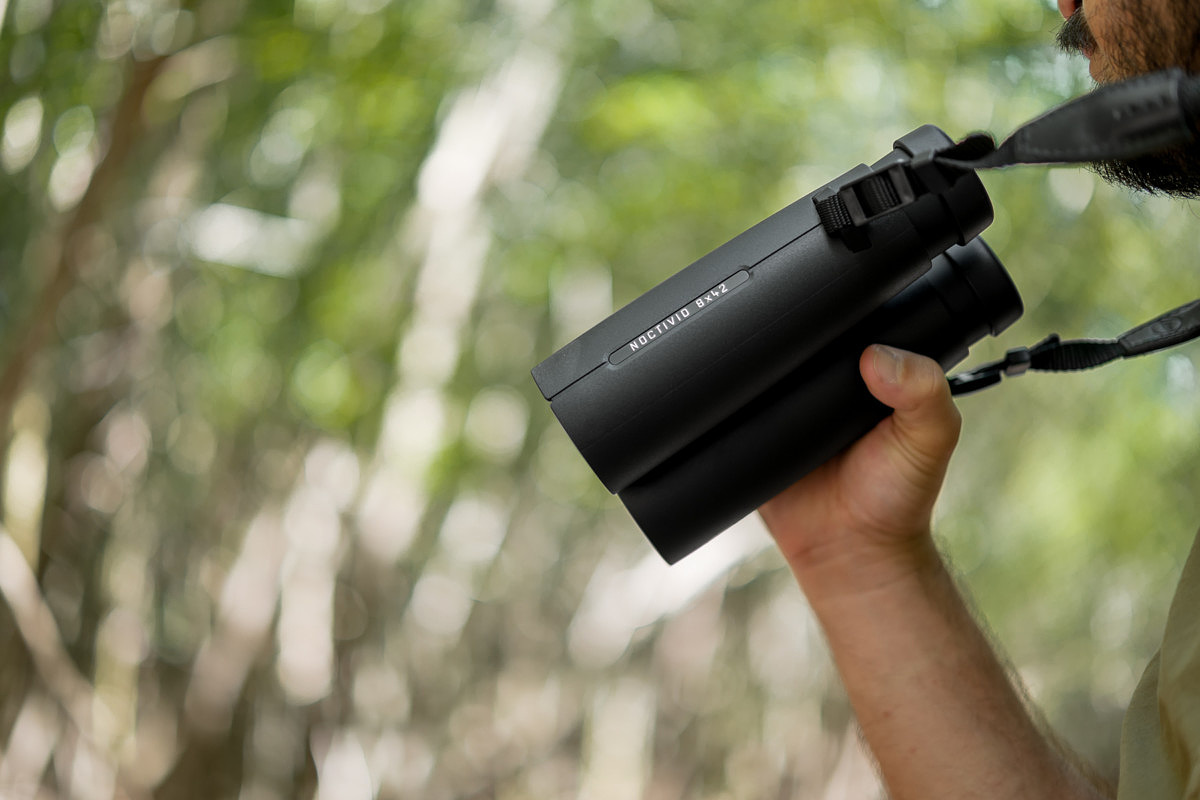
Every pair of binoculars
is described by two numbers: lens magnification and lens diameter.
(Pictured: Leica 8×42 Noctivid, Black)
(Pictured: Leica 8×42 Noctivid, Black)
Lens Diameter
This brings me to the
second number we see: the diameter of the objective lens where light initially
enters the ocular (the front element). Think of this as aperture on a lens. The
larger the lens opening diameter, the more light enters, resulting in a brighter
image. While not a direct equivalence, there are many parallel concepts to a
camera lens, which we’ll dive into deeper in just a bit. Full-size Leica
binoculars range in diameter from 32 to 50mm, and compact binoculars range from
20 to 25mm. Basically, the bigger the number, the larger the lens diameter.
Exit Pupil
Now that we know what each
of these numbers mean individually, let’s take a look at what they mean
together. This is where a little basic math comes into play. Let’s take a pair
of 8×42 binoculars as an example. If we divide the diameter of 42mm by the
magnification of 8x, we’re left with a smaller number – in this case 5.25. This
number is our exit pupil.
LENS DIAMETER ÷
MAGNIFICATION = EXIT PUPIL
What is the exit pupil,
you ask? Let me show you.
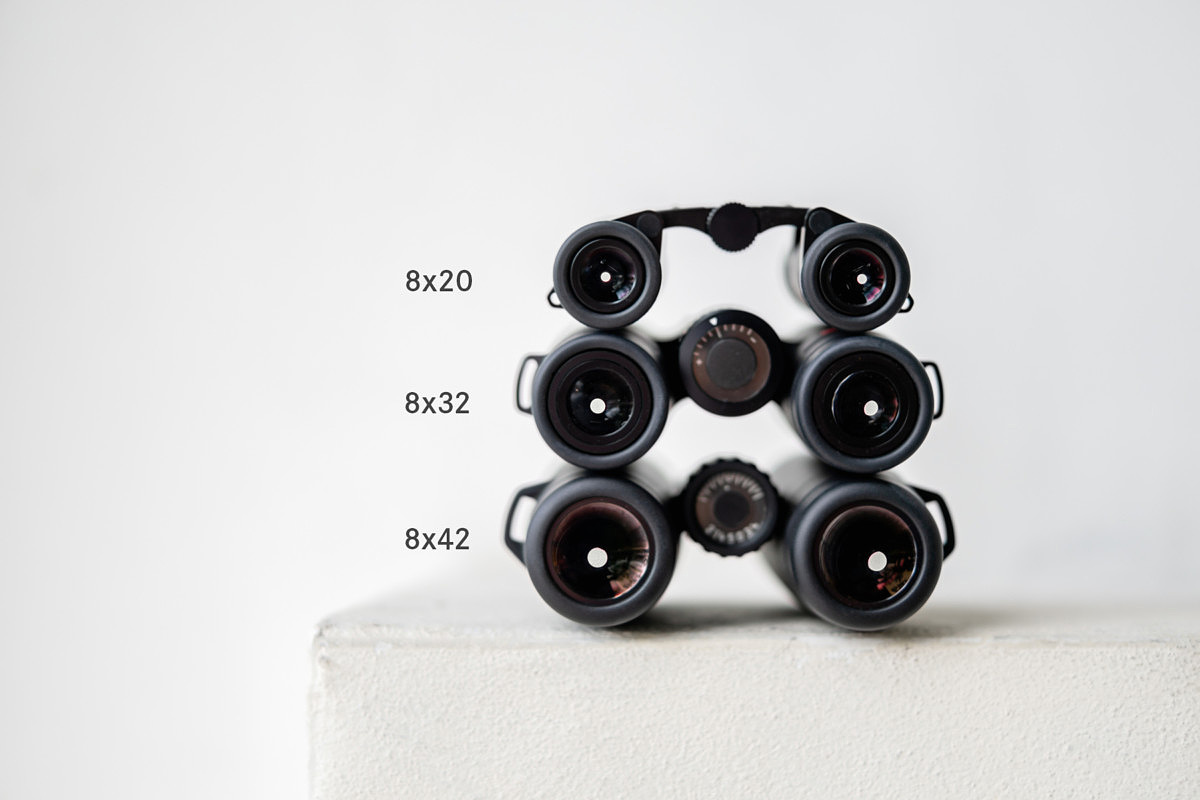
The exit pupil, measured
in millimeters, is that tiny circle of light you can see coming through the
lens.
The exit pupil is that
tiny circle of light you can see coming through the lens. In the above photo, I
lined up three binoculars, all with the same magnification (8x), but with
different lens diameters. You’ll notice, not surprisingly, that the binoculars
with the smaller diameter have a smaller exit pupil.
In terms of viewing
experience, the smaller the exit pupil, the more your eye has to search (and
strain) to see the entire image. Imagine being in a room with floor-to-ceiling
windows. You can take in the full view while sitting on the couch. Now imagine
being in the same room, but instead of expansive full-length windows, you have
a single nautical bull’s-eye window. To take in the same view, you’d have get
up close to the window and crane your neck up and down, left and right. Your
eye, on a smaller scale, has to do the same when looking through a binocular
with a small exit pupil.
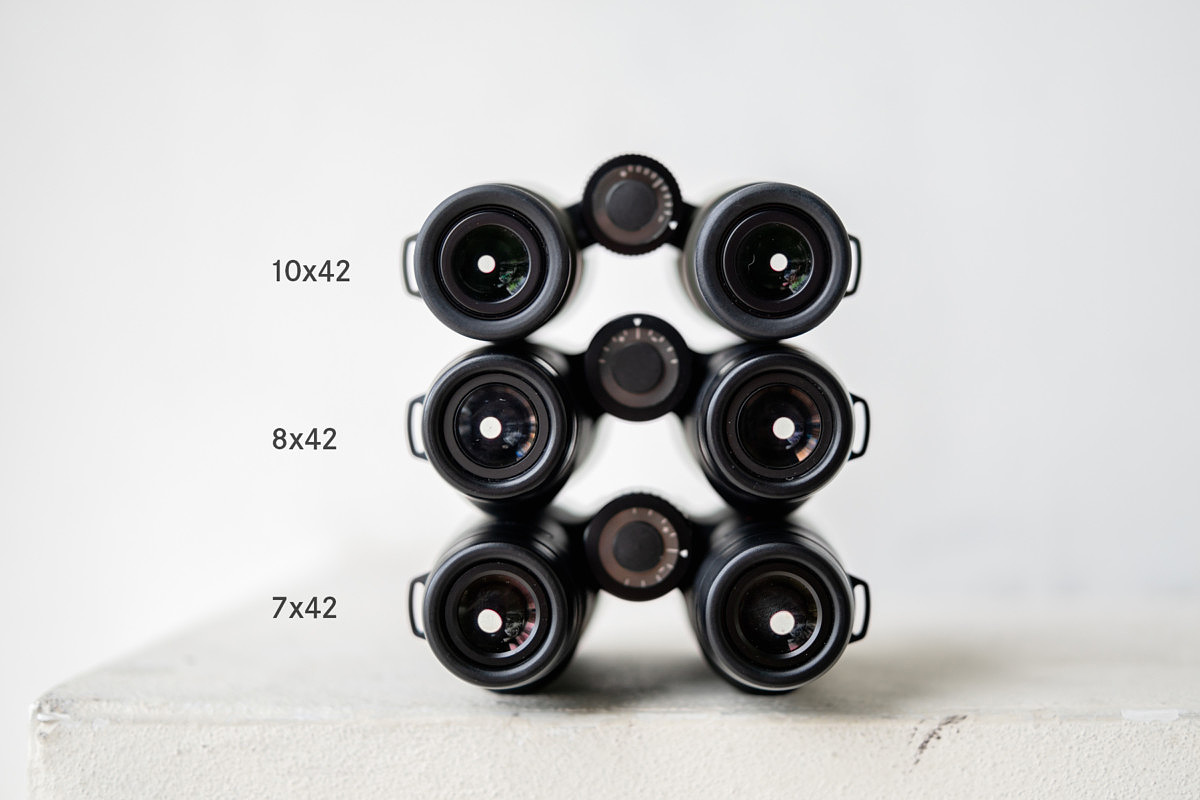
The magnification of the
lens affects the exit pupil just as much as the diameter – more magnification
isn’t necessarily better.
Now let’s take a look at
another series of binoculars, all with the same ocular diameter of 42mm, but
with different magnifications. On the bottom we have a birding classic, the
7×42 Ultravid HD-Plus, in the middle the 8×42 Ultravid HD-Plus, and on the top
the 10×42 Noctivid. You can see that the magnification of the lens affects the
exit pupil just as much as the diameter, and that more magnification isn’t
necessarily always better. By giving up some magnification, we increase the
size of the exit pupil as well as the field of view. For those using binoculars
for extended periods of time, the roomier exit pupil of a 7x or 8x binocular
reduces strain on the eye, allowing you to stay out in field longer.
It seems like a
no-brainer. Just get the binocular with the largest exit pupil, right? If only
it were that simple. A larger exit pupil generally results in a larger
binocular. This is where I equate binocular objectives to photographic lenses.
If you’re familiar with Leica M lenses, you’ve probably heard of the legendary
50mm Noctilux-M f/0.95. Of the five 50mm M lenses Leica makes, the Noctilux has
the widest aperture and lets in the most light, allowing you to photograph with
almost zero available light. However, this see-in-the-dark lens comes at a
price, and not just a monetary one. Tipping the scales at 1.54 lbs, it’s twice
as heavy as any other 50mm M lens. While the Noctilux looks great on paper,
once mounted on a camera body, some may find it too weighty for everyday use.
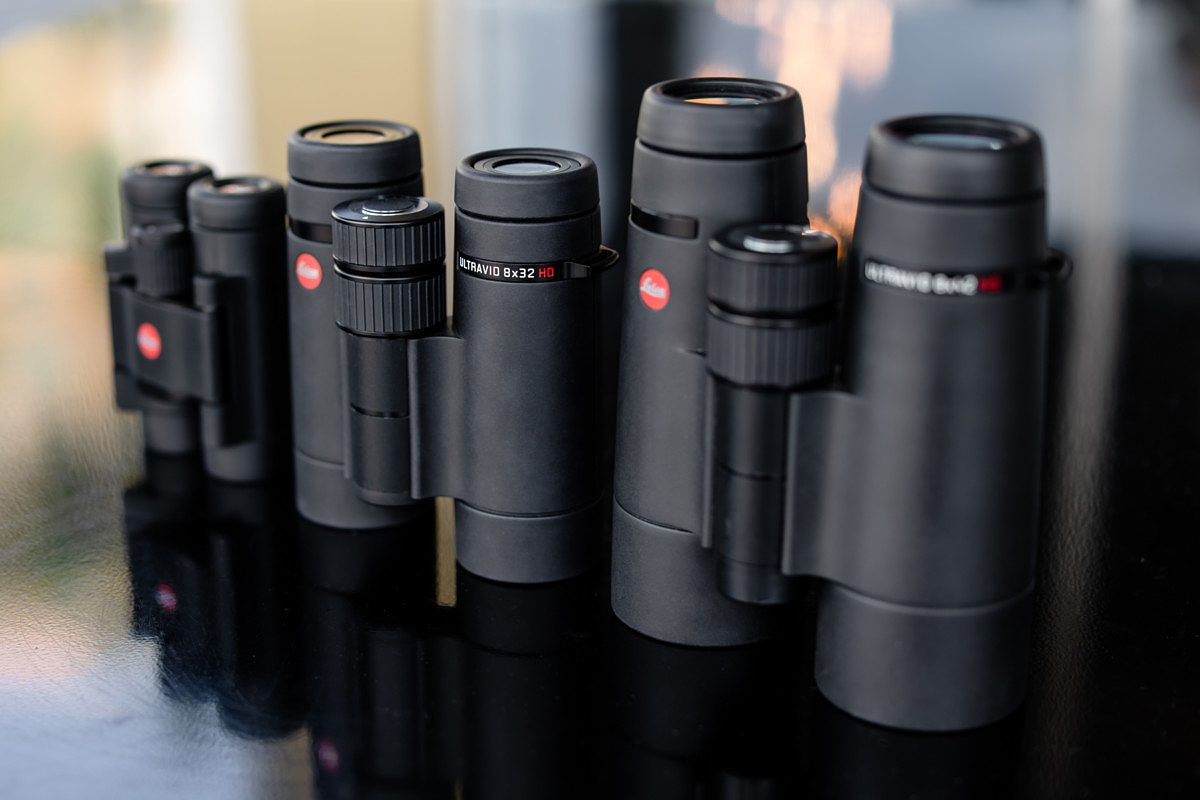
Just like a camera lens,
the decision when buying a binocular comes down to weight/size versus viewing
experience.
(From left to right: Leica 8×20 Ultravid, Leica 8×32 UltravidHD-Plus, Leica 8×42 Ultravid HD-Plus)
(From left to right: Leica 8×20 Ultravid, Leica 8×32 UltravidHD-Plus, Leica 8×42 Ultravid HD-Plus)
Just like a camera lens,
the decision when buying a binocular comes down to weight/size versus viewing
experience. For those who use binoculars casually and travel often, sacrificing
some field of view for convenience and size makes sense. However, for those who
will be doing more intense viewing, a full-size binocular with a wider field of
view is a better solution.
Now that we have a decent
grasp on lens magnification and diameter, let’s take a look at some of the
other common terms we see thrown around such as field of view, eye relief and
AquaDura.
Binocular Terminology
Field of View (FOV) –
Largely a function of magnification, field of view refers to how much of
a scene you can see through the binoculars, and is measured in ft/m at a 1,000
yards. For instance, when looking through the Noctivid 8×42 at a scene 1,000
yds away, the binocular’s viewing image spans 404 ft of that scene. A binocular
with a stronger magnification (10x) will have a smaller field of view than a
binocular with less magnification (7x). While magnification directly affects
the field of view, it is not the sole contributing factor. The optical design
of the binocular also comes into play. We can see this with Leica’s line-up of
full-size 8×42 binoculars. Even though the Noctivid, Ultravid HD-Plus and
Trinovid HD all have the same magnification and lens diameter, each has a
slightly different field of view. Generally, a larger FOV at the same
magnification is preferable.
Binocular Model FOV at 1,000 yards
Nocitivid 8×42 404 feet
Ultravid 8×42 HD-Plus 389 feet
Trinovid 8×42 HD 372 feet
Eye Relief –
Measured in millimeters, eye relief denotes what the distance between
your eye and the last optical element (where you place your eyes to look
through the binoculars) should be in order to take advantage of the binocular’s
entire viewing image. For eyeglass wearers,adequate eye relief is particularly
important. Even though all Leica binoculars come with twist-down collapsible
eye cups to adjust the distant between your eye and the lens, depending on the
eyeglasses and the binoculars, it may not be possible to achieve the optimal
eye relief distance, significantly reducing the field of view and overall
experience. If you’re an eyeglass wearer, look for a binocular with greater eye
relief (at least 15mm). The Leica Noctivids boast an incredibly comfortable eye
relief of 19mm.
AquaDura® – A
water resistant lens coating applied to nearly all current Leica binoculars,
AquaDura® repels water and dirt and resists scratching. Raining? No problem, a
quick flick of the binocular and the water beads practically jump off the lens.
So now that we’re experts,
let’s take a look at Leica’s current line up of sport optics.
Noctivid
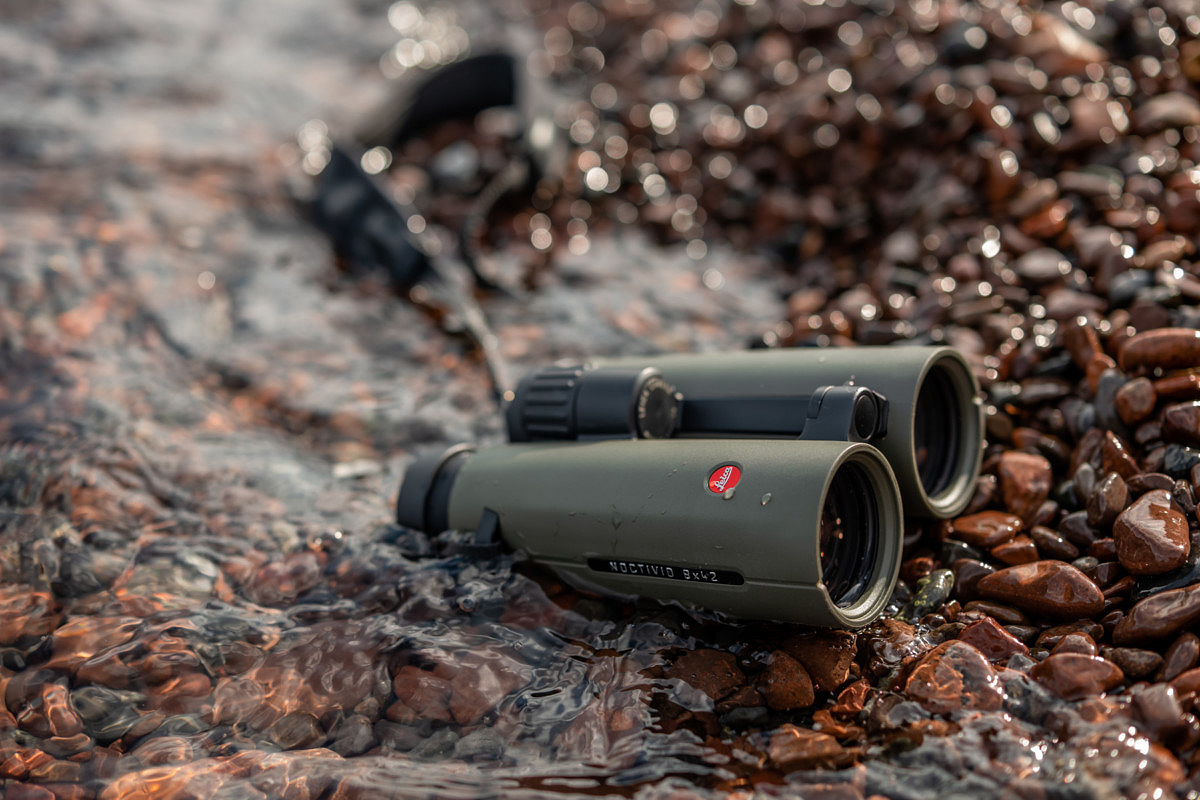
Released in August 2016,
the Noctivids are Leica’s highest performing binocular and are a testament to
Leica’s 110 years of experience in optical design.
Released in August 2016,
the Noctivids are Leica’s highest performing binocular and are a testament to
Leica’s 110 years of experience in optical design. The Noctivid is the first of
a new line of binoculars, boasting not only improved optics using 100% Schott
glass, but also a completely new open-bridge construction for flawless
ergonomics.
Even the naming is new.
Take the famed Leica Noctilux-M again. I’m somewhat of word nerd and am always
looking at how words are constructed. Notice the parallel prefixes: nocti-lux,
nocti-vid. I can’t imagine this was a coincidence on Leica’s part. Noct- in
Latin means “night.” Like the Noctilux-M, the Noctivids perform exceptionally
well in low-light conditions. I often have people compare the Noctivid to the
Ultravid HD-Plus by looking at a photograph at the end of a dimly lit hallway.
The immediate response is always “wow.” The difference is staggering. The
Noctivids’ light-gathering ability results in a viewing image brighter than
what the naked eye can see. Even at dawn and dusk when light is fleeting, the
Noctivids produce a sharp, contrasty image with perfect color reproduction.

Noct- in Latin means
“night.” Like the Noctilux-M, the Noctivids perform exceptionally well in
low-light conditions.
Besides their optical
brilliance, the Noctivids’ ergonomics set them apart. An open-bridge focusing
shaft and thin optical tubes make the Noctivids easy to hold, even
single-handed. Despite the Noctivids coming in slightly heavier (about 100
grams) than their Ultravid HD-Plus counterparts, they’re actually more
comfortable to hold. The majority of the glass inside is positioned so that
most of the weight rests in the palm of your hand. I find I am able to
comfortably hold up a Noctivid to my eyes much longer than other binoculars of
similar size and weight. Adding to the comfort factor, the Noctivids have a
long eye relief of 19mm, making them ideal for eyeglass wearers.
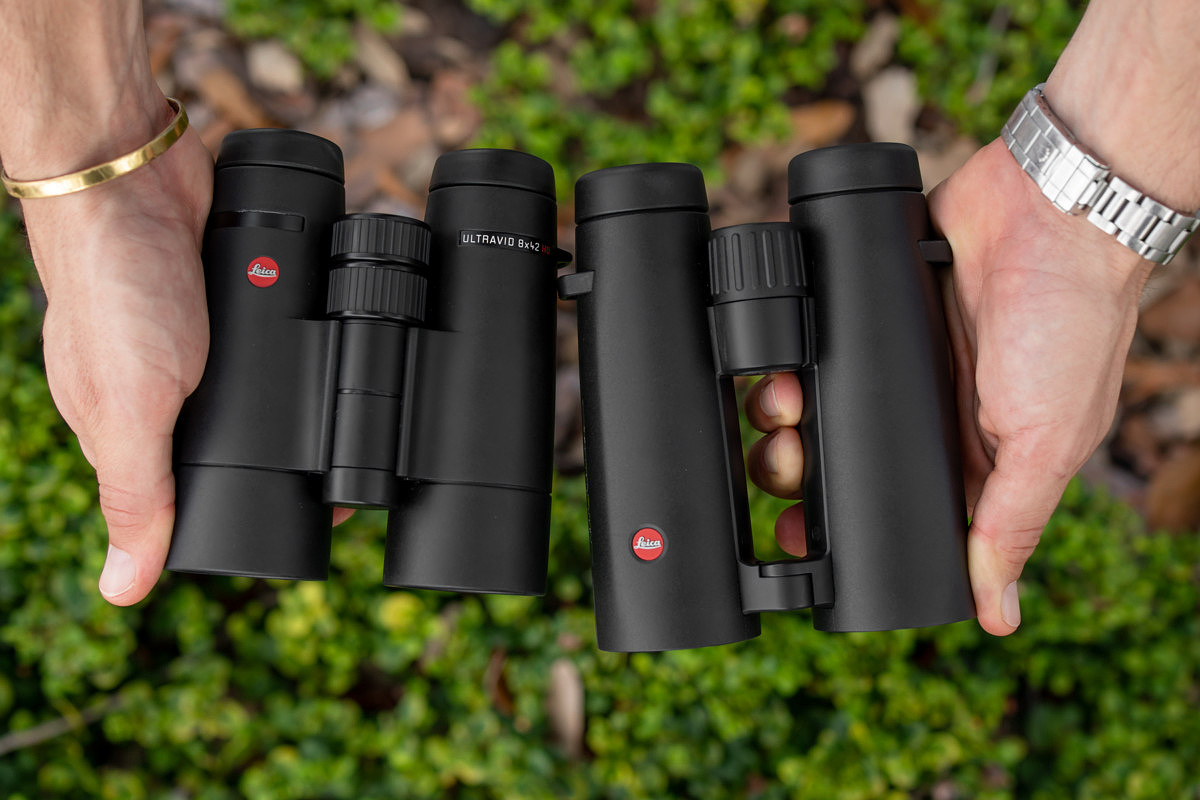
An open-bridge focusing
shaft and thin optical tubes make the Noctivids easy to hold, even
single-handed.
(Left: Noctivid 8×42, Right: Ultravid 8×42 HD-Plus)
(Left: Noctivid 8×42, Right: Ultravid 8×42 HD-Plus)
Bottom line – the
Noctivids are hands-down, not only the best binocular in Leica’s line-up, but
currently the highest performing binocular on the market. If you want the best
binocular out there, look no further.
Top Noctivid Picks –
Both. The 8×42 Noctivid has a generous exit pupil, wide field of view,
and a long eye relief making it great for boaters, birders, and just about
anybody looking for an all-around amazing binocular. The extra magnification of
the 10×42 Noctivid combined with easy hand-holding make it a great pick for
hawkwatchers and hunters.
Ultravid HD-Plus
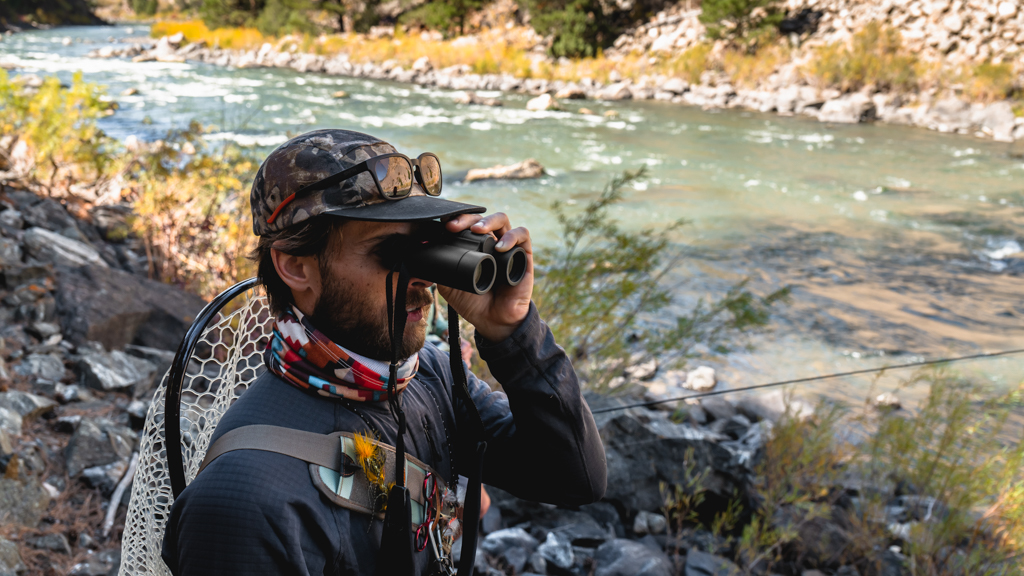
The Ultravid 8×32 HD-Plus
is the smallest full-sized binocular that Leica offers, making it great for
hiking and travel.
The first Ultravid (BR)
was released in 2003 and updated in 2007 with the Ultravid HD. The Ultravid
HD-Plus binoculars, introduced at Photokina in 2014, are the third generation
of Ultravids and paved the way for the Leica Noctivid. The HD-Plus line introduced
Schott HT glass, which substantially increased light transmission and redefined
the viewing experience.
While the higher-end
Noctivids are only available in 8×42 and 10×42, the Ultravid HD-Plus comes in
eight different flavors, ranging from 7-10x and 32-50mm, making it Leica’s most
comprehensive line of sport optics. The Ultravid HD-Plus’ are constructed using
the same optical coatings and nitrogen-filled magnesium body as the Noctivids
and deliver exceptional results. Because of the wide range of models available,
Ultravid HD’s fit many different needs. The Ultravid 8×32 HD-Plus is Leica’s
most compact full-sized binocular, making it ideal for serious birders and
nature buffs who want to pack light. For those in need of a wide field of view,
the Ultravid 7×42 HD-Plus with an FOV of 420ft/140m is the go-to.
Throughout the last 15
years, the Ultravids in all their iterations have been Leica’s benchmark
binocular and several special editions were produced including collaborations
with Hermes, Zagato & Aneas.
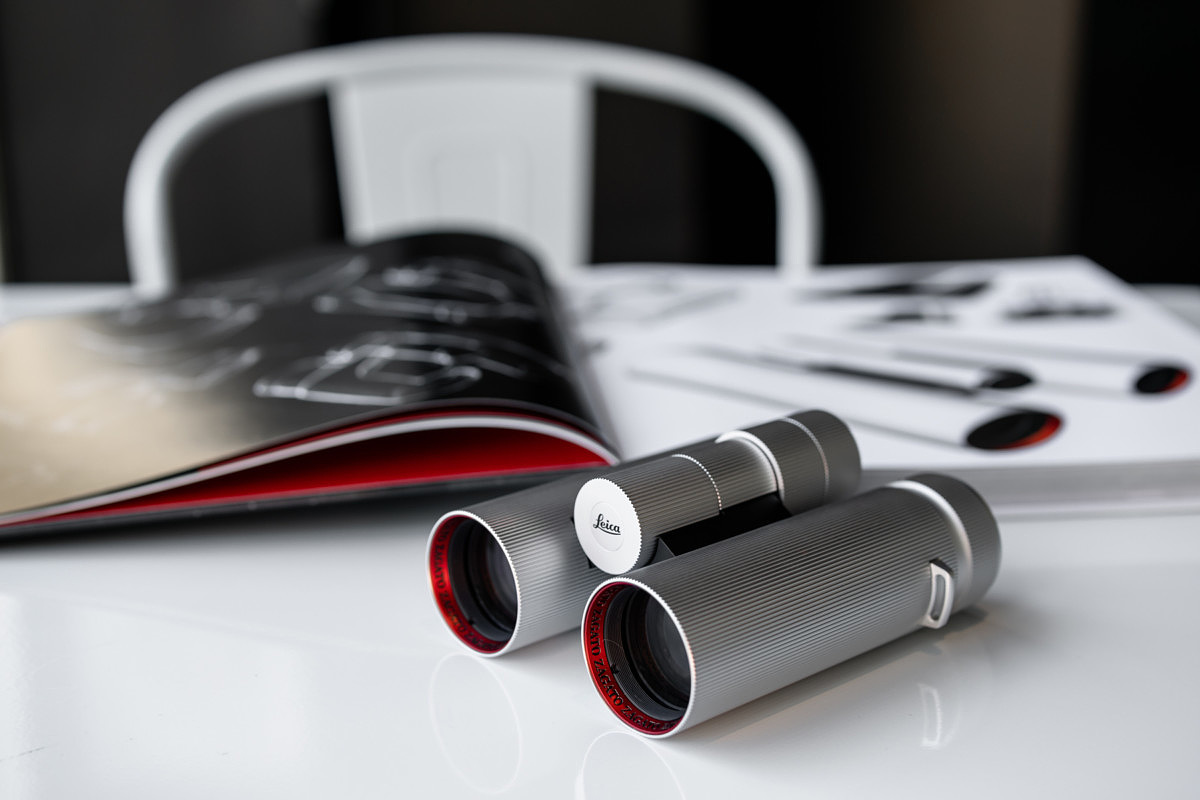
The Leica Ultravid 8×32‘Edition Zagato’ released in September 2015 and limited to 1,000 pieces
worldwide.
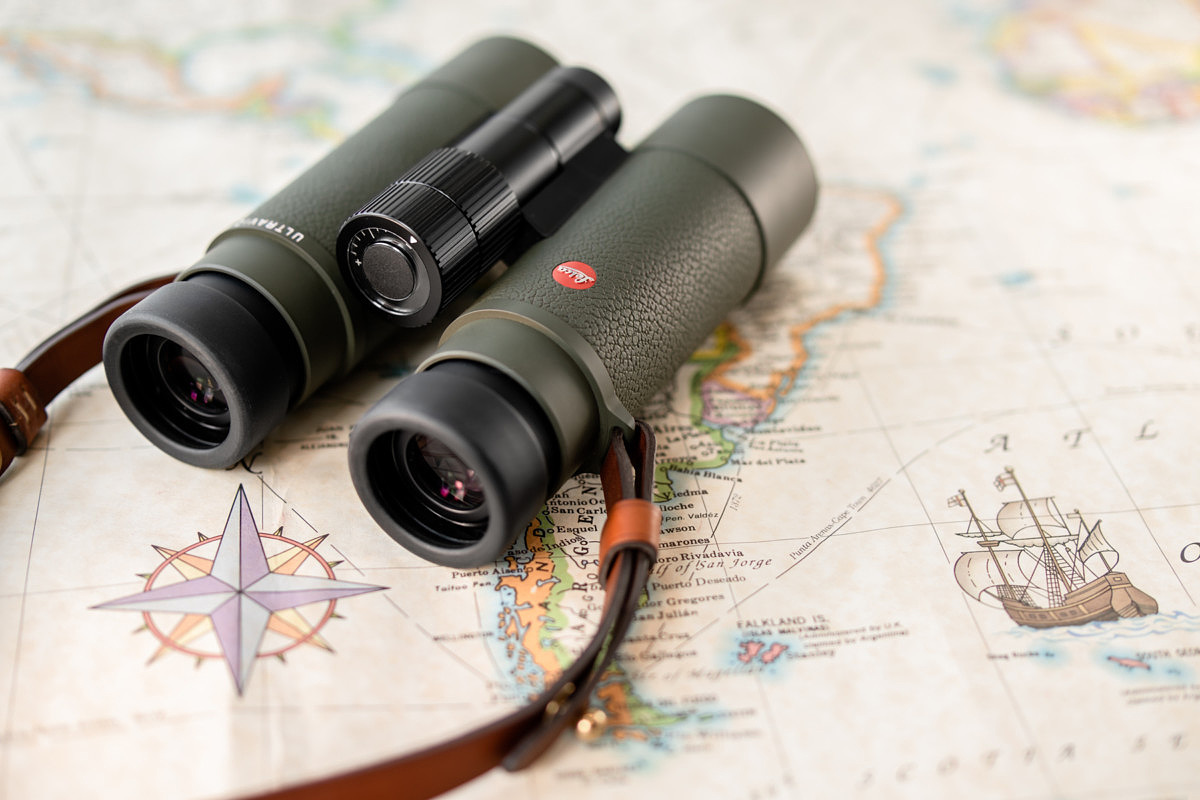
The Leica Ultravid HD-Plus‘Edition Safari’ released in February 2017 features a handcrafted strap and
case by by French bag-maker Aneas. Only 100 of each model was made.
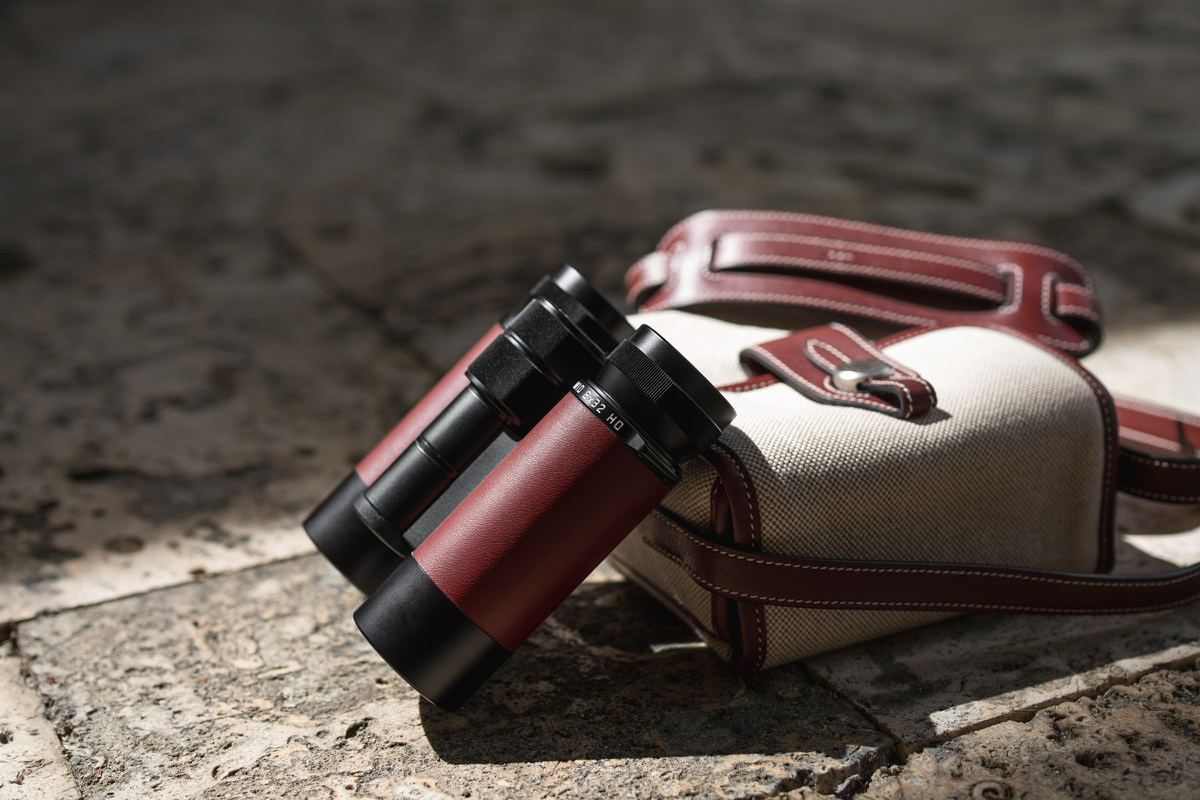
The Leica Ultravid 8×32HD-PLUS, Edition Hermes was released in January 2016 celebrated 111 years of
Leica Sport Optics and thus was limited to 111 pieces worldwide.
Top Ultravid HD-Plus
Picks: The Ultravid 8×32 HD-Plus is the smallest full-sized binocular that
Leica offers, making it great for hiking and travel. It’s the “baby bear” of
binoculars – not too big, not too small – just right.
Trinovid HD
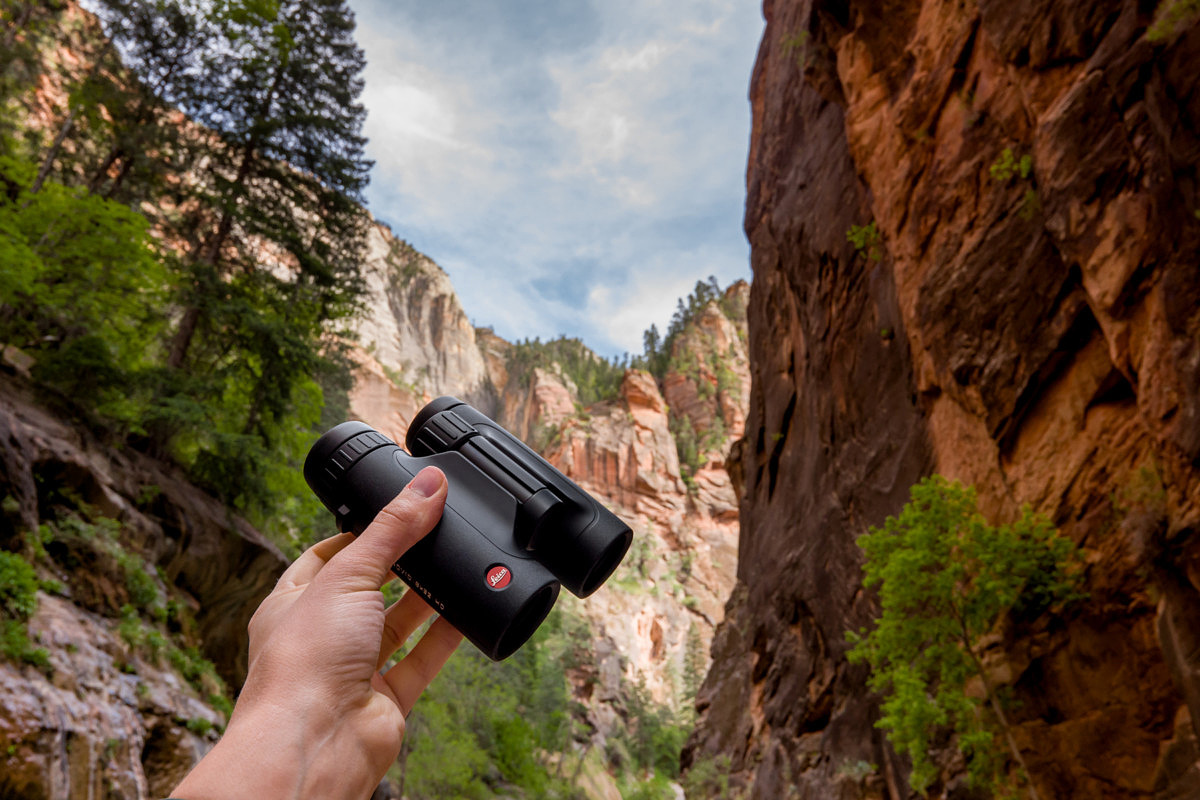
The Trinovid 8×32 HD is
similar in size and weight to the much-loved Ultravid 8×32 HD-Plus, and they
offer a closer minimum focusing distance and a more comfortable eye relief at
half the price.
The original Leica
Trinovid was announced in 1958 and was named it for its three (tri-) novel
(-no-) innovations: a redesigned compact and ergonomic design, an internal
focusing system, and of course ground-breaking optical performance.
Unfortunately, this Trinovid – the first of this name – didn’t make it far. The
cost of production was too high, rendering it unaffordable for even the
wealthiest of consumers.
Sixty years of Trinovid
designs have led to the current HD model. For this generation of Trinovid,
announced in December 2015, Leica was not only able to reduce their production
cost, they were able to develop the industry’s highest performing binocular
under $1,000. Don’t let the lower price tag fool you though. The Trinovids feel
and perform like a Leica should, incorporating Leica’s patented HDC and
AquaDura lens coatings found in their higher end models.
Aside from the attractive
price tag, the Trinovid HD’s offer several other class-leading advantages
including an extremely close minimum focusing distance: 3.3ft for the 32mm
models and 6ft for the 42mm’s. A close-focusing binocular allows you to dial in
details of plants, butterflies and even the Mona Lisa.
Top Trinovid HD Picks – The
Trinovid 8×32 HD is reminiscent of the much-loved Ultravid 8×32 HD-Plus.
Similar in size and weight, the Ultravid HD-Plus of course has the optical
advantage of the Schott HT glass, but the Trinovid HD actually offers a longer
eye relief (17mm as opposed to 13.3mm) and a closer minimum focusing distance.
Compact Sport Optics
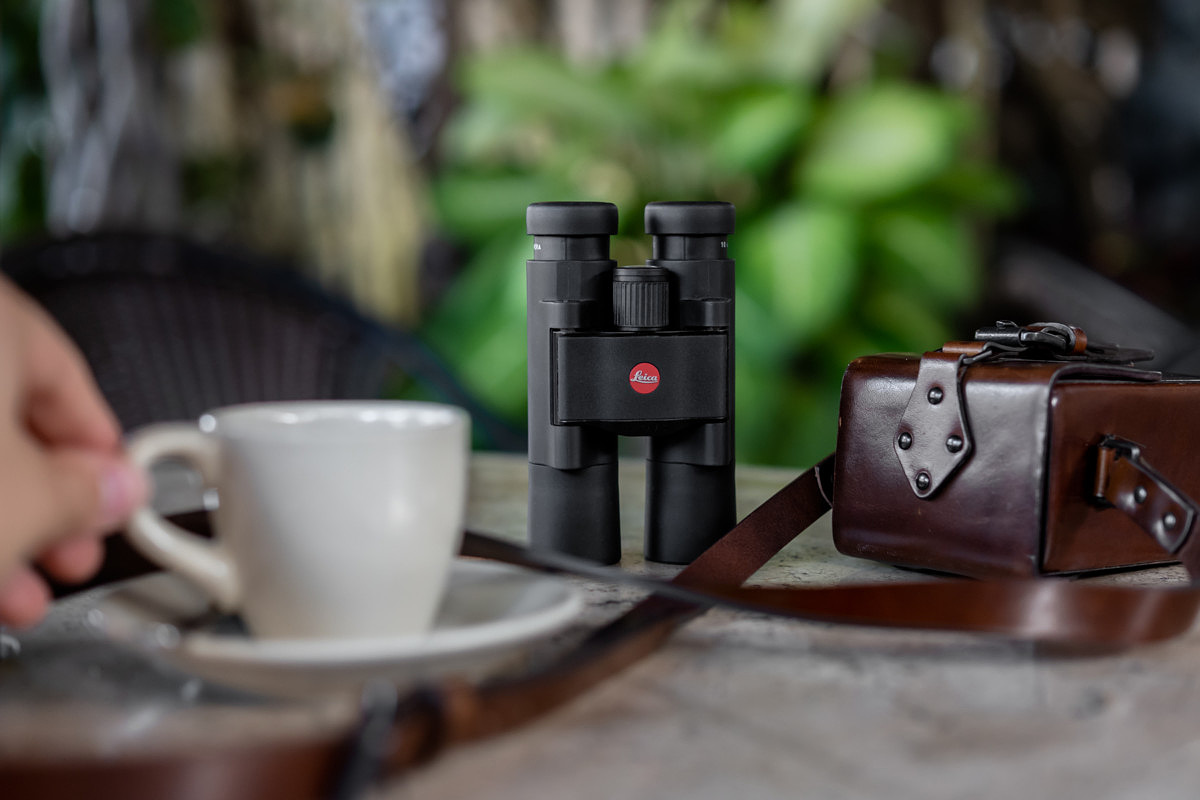
Leica compact Ultravids
and Trinovids offer high end optics in a pocket-sized package.
Leica compact sport optics
appeal most to the casual binocular user – the theater goers and the sporting
event attendees. Leica compact Ultravids and Trinovids offer high end optics in
a pocket-sized package. Compact optics don’t offer the larger exit pupils and
field of view of full-sized binoculars and will lead to eye fatigue sooner than
their full-sized counterparts. However, for those wanting a just-in-case
binocular, look no further. Weighing just half a pound and sized similar to a
deck of cards, you’ll hardly notice these binoculars in your camera bag or
travel pack.
Top Compact Picks – The
Leica compact Ultravids are waterproof up to 16.5ft/5m, whereas the Trinovid
compacts are only splashproof. This in itself makes the jump in cost worth it.
Of the two compact Ultravids available, the 8×20’s has a larger exit pupil and
wider field of view for a more comfortable viewing experience.
For technical data go here
For other articles on this blog please click on Blog Archive in the column to the right
To comment or to read comments please scroll past the ads below.
All ads present items of interest to Leica owners.
__________________________________________________________________________
For other articles on this blog please click on Blog Archive in the column to the right
To comment or to read comments please scroll past the ads below.
All ads present items of interest to Leica owners.
__________________________________________________________________________

Buy vintage Leica cameras from
America's premier Leica specialist

Buy vintage Leica cameras from
America's premier Leica specialist
Click on image to enlarge
Order: info@gmpphoto.com
Please make payment via PayPal to GMP Photography
Click on image to enlarge
Order: info@gmpphoto.com
Click on image to enlarge
Order: info@gmpphoto.com
Click on image to enlarge
Order: info@gmpphoto.com
Please make payment via PayPal to GMP Photography
Click on image to enlarge
Order: info@gmpphoto.com
Please make payment via PayPal to GMP Photography
Click on image to enlarge
Order: info@gmpphoto.com
Please make payment via PayPal to GMP Photography














No comments:
Post a Comment